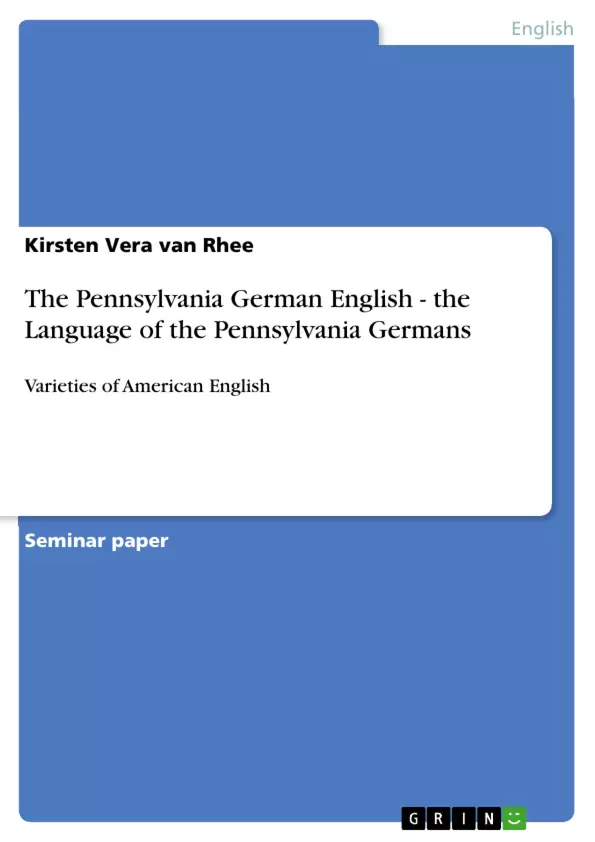The long persistence of Pennsylvania German English for nearly
two centuries in an English-speaking territory which was settled
by English, Scotch-Irish and Welsh as early as by Germans , naturally brought about a certain contact between English and
German language that influenced both, the generally spoken English and the specific dialect formation that languages borrowed from
each other.
This paper is an attempt to show in how far this language
contact has caused mutual language borrowings, which were by no means restricted to vocabulary items but also extended to phonological and syntactic features, having as well influential effects on intonational patterns.
Table of Contents
- Introduction
- The Pennsylvania German English
- The beginnings
- Geographical distribution of Pennsylvania speech areas
- Social aspects of the Pennsylvania German society
- Lexical borrowings
- Adlexification
- Relexification
- Phonological borrowings
- The consonants
- Plosives
- Fricatives
- Vowels
- Later and earlier borrowings
- The Pennsylvania German Syntax
- Preservation
- The subject-object-verb structure
- The finite verb remains in second position
- Converge
- Innovation
- Intonation
- The rising and falling of the terminal pitch
- The rising terminal pitch
- The falling terminal pitch
- The rise-rise-fall pattern
- Conclusion
Objectives and Key Themes
This paper aims to demonstrate the influence of language contact between English and Pennsylvania German, which extends beyond mere vocabulary and encompasses phonological and syntactic features, as well as intonation patterns. The paper explores the linguistic borrowing that occurred in both languages, focusing on:- The historical development and geographical distribution of Pennsylvania German English.
- The social and linguistic differences between Plain Pennsylvania German speakers (PPG) and Nonplain Pennsylvania Germans (NPG).
- The analysis of lexical borrowing processes, including adlexification and relexification.
- The investigation of phonological borrowings, examining the influence of German on English consonants and vowels.
- The impact of German on Pennsylvania German syntax, particularly in terms of word order and verb placement.
Chapter Summaries
The introduction sets the stage for the paper, highlighting the enduring influence of Pennsylvania German English in an English-speaking territory. It emphasizes the mutual linguistic borrowings between English and German, extending beyond vocabulary and encompassing phonological, syntactic, and intonational features. The second chapter delves into the origins and geographical distribution of Pennsylvania German English, tracing its roots to early German settlers and their various dialectal influences. It emphasizes the unique blend of dialects that formed Pennsylvania German and its continued prevalence, especially in the Rhenish Palatinate dialects. The chapter further outlines the geographical spread of Pennsylvania German, encompassing southeastern Pennsylvania counties and extending into other regions of North America. The chapter concludes by discussing the social aspects of the Pennsylvania German society, differentiating between the sectarian and non-sectarian groups. It highlights the linguistic and cultural differences between these groups, with Plain Pennsylvania German speakers (PPG) maintaining a stable bilingualism and Nonplain Pennsylvania Germans (NPG) experiencing a gradual shift towards American English monolingualism.Keywords
This paper focuses on the linguistic phenomena of language contact and bilingualism, particularly within the context of Pennsylvania German English. Key terms include: Pennsylvania German, English, language contact, lexical borrowings, phonological borrowings, syntactic features, intonation patterns, adlexification, relexification, Plain Pennsylvania German (PPG), Nonplain Pennsylvania German (NPG), and bilingualism.- Quote paper
- Kirsten Vera van Rhee (Author), 1993, The Pennsylvania German English - the Language of the Pennsylvania Germans, Munich, GRIN Verlag, https://www.grin.com/document/178114



